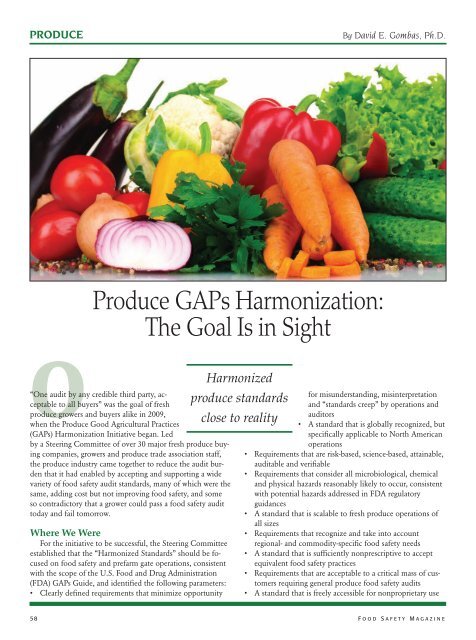Food Safety Magazine - June/July 2013
Food Safety Magazine - June/July 2013
Food Safety Magazine - June/July 2013
You also want an ePaper? Increase the reach of your titles
YUMPU automatically turns print PDFs into web optimized ePapers that Google loves.
PRODUCE<br />
By David E. Gombas, Ph.D.<br />
Produce GAPs Harmonization:<br />
The Goal Is in Sight<br />
O“One audit by any credible third party, acceptable<br />
to all buyers” was the goal of fresh<br />
produce growers and buyers alike in 2009,<br />
when the Produce Good Agricultural Practices<br />
(GAPs) Harmonization Initiative began. Led<br />
by a Steering Committee of over 30 major fresh produce buying<br />
companies, growers and produce trade association staff,<br />
the produce industry came together to reduce the audit burden<br />
that it had enabled by accepting and supporting a wide<br />
variety of food safety audit standards, many of which were the<br />
same, adding cost but not improving food safety, and some<br />
so contradictory that a grower could pass a food safety audit<br />
today and fail tomorrow.<br />
Where We Were<br />
For the initiative to be successful, the Steering Committee<br />
established that the “Harmonized Standards” should be focused<br />
on food safety and prefarm gate operations, consistent<br />
with the scope of the U.S. <strong>Food</strong> and Drug Administration<br />
(FDA) GAPs Guide, and identified the following parameters:<br />
• Clearly defined requirements that minimize opportunity<br />
Harmonized<br />
produce standards<br />
close to reality<br />
for misunderstanding, misinterpretation<br />
and “standards creep” by operations and<br />
auditors<br />
• A standard that is globally recognized, but<br />
specifically applicable to North American<br />
operations<br />
• Requirements that are risk-based, science-based, attainable,<br />
auditable and verifiable<br />
• Requirements that consider all microbiological, chemical<br />
and physical hazards reasonably likely to occur, consistent<br />
with potential hazards addressed in FDA regulatory<br />
guidances<br />
• A standard that is scalable to fresh produce operations of<br />
all sizes<br />
• Requirements that recognize and take into account<br />
regional- and commodity-specific food safety needs<br />
• A standard that is sufficiently nonprescriptive to accept<br />
equivalent food safety practices<br />
• Requirements that are acceptable to a critical mass of customers<br />
requiring general produce food safety audits<br />
• A standard that is freely accessible for nonproprietary use<br />
58 F o o d S a f e t y M a g a z i n e






![Otomatik indirilmez ise tıklayınız [Download]](https://img.yumpu.com/44170525/1/190x190/otomatik-indirilmez-ise-taklayanaz-download.jpg?quality=85)










